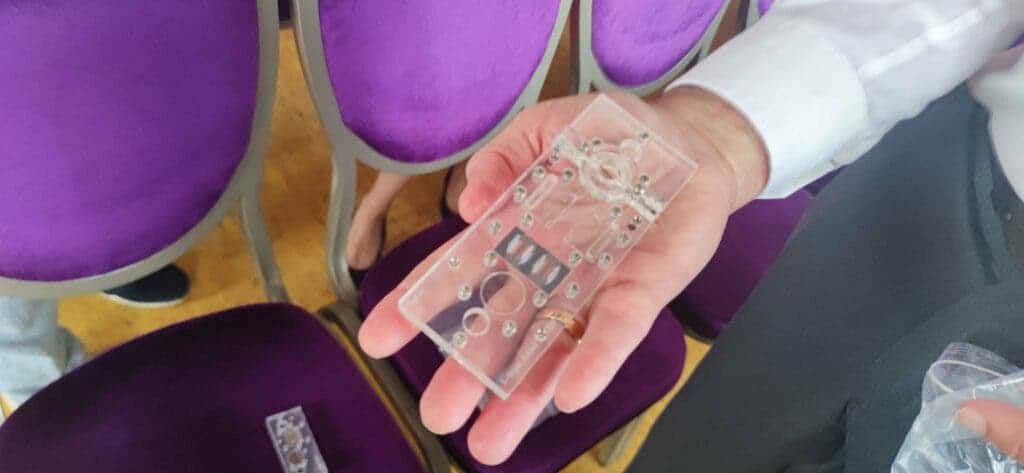
Microphysiological systems, also known as organ-on-a-chip systems, are able to replicate key aspects of the human body and its function. These devices can be used with various living human cells to accelerate drug development, disease modeling, and personalize medicine — and the field is growing fast.
Now, researchers in the United States have used an advanced microphysiological system that mimics the pathology of chronic inflammatory demyelinating polyneuropathy and multifocal motor neuropathy, two very rare but very devastating neuromuscular diseases that cannot be replicated in animal models like rodents or primates.
The cost to bring a new drug to the market can be as high as $2.6 billion. This staggering figure isn’t owed to some inherently expensive aspect of pharma research, at the individual study level, but rather due to the very high attrition rate for drug discovery research. For every new molecule that actually works or at least doesn’t make you sicker than before, there are many other duds.
With better predictive tools, it could be possible to greatly reduce the heavy cost burden of this development process. For instance, if you can determine that a drug candidate is not suitable before commencing clinical trials, you’d save a lot of money and time by not pursuing a dead-end lead. This is one of the reasons why research in microphysiological systems has been encouraged significantly over the years, especially since 2012 when the National Institutes of Health (NIH) and the Defense Advanced Research Projects Agency (DARPA) funded some of the first major projects.
Cutting costs without hurting animals
These microphysiological devices are not only useful substitutes to traditional preclinical cell culture methods, but could significantly reduce the use of in vivo animal studies. Actually, in some instances, animal studies aren’t even possible, which is the case for the two above-mentioned conditions.
Both diseases are very rare autoimmune conditions characterized by muscle weakness that impairs the patient’s walking, hand dexterity, and other motor functions. The conditions are owed to an immune system overreaction, which produces antibodies that cause peripheral nerve demyelination and reduce nerve conduction velocity.
Patients are usually treated with steroids and intravenous immunoglobulin, but some don’t respond well, thereby underscoring the importance of finding new treatments.
This is where the human-on-a-chip in vitro system developed by Orlando-based Hesperos came in. Researchers at Hesperos, Sanofi, Duke University, and the University of Central Florida developed a tissue chip model consisting of motoneurons and Schwann cells. Motoneurons are responsible for relaying chemical and electrical messages from the brain to muscles, whereas Schwann cells help these signals travel faster.
When these cells were exposed to blood serum from people with the rare diseases, the cells were attacked by immune system antibodies. This caused the motoneuron signals to move much more slowly than normal, just like what you see happening in the brain of human patients.
The cells were treated with TNT005, an antibody developed by Sanofi that inhibits the immune system reaction, restoring the neurons’ tissue and messaging speed to normal, the authors reported in the journal Advanced Therapeutics.
These promising results convinced the FDA to approve clinical trials to test the efficacy of the drug against rare neuromotor diseases. It’s one of the first times a candidate drug is being tested in people using primarily tissue chip data — but this is likely just the beginning.
“The biggest doubt for this field was regulatory acceptance by FDA and EMA, so the FDA accepting the efficacy data (does the drug work?) for a human-on-a-chip system in an Investigational New Drug (IND) application to allow a clinical trial to proceed is a tremendous hurdle now cleared for the entire field,” James Hickman, Chief Scientist at Hesperos and Professor at the University of Central Florida, told ZME Science.
“We have been successfully linking various organ-on-a-chip systems to have multi-organ systems with clinically relevant functional readouts ( such as muscle contraction, electrical activity, etc) in a medium without calf serum. Now that we have the start of regulatory acceptance we can do additional rare diseases for efficacy and begin to plan out how to get regulatory acceptance for safety next,” Hickman added.
There are over 7,000 rare diseases with no effective treatments, and only about 400 are being actively researched due to a variety of reasons, including the lack of animal models. Moreover, about 9 in 10 drug candidates that show promising results in tests on rodents eventually fail in clinical trials on humans.
Having mini-brains, mini-kidneys, and mini-hearts on a chip could provide a much more reliable in vitro platform for researching drugs and could lead to some exciting opportunities in research, especially in genetics and personalized medicine. However, for now, microphysiological systems for drug discovery are most suited to repurposing existing drugs since animal models are still the gold standard in preclinical trials, as far as safety goes.
“In the revolutionary transition in biomedicine from animals to relevant human models, Hesperos has achieved an important milestone. FDA authorized the system as proof of efficacy to move into human trials for a new use of a drug without animal data, showing that the most important agency for drug approval is open for this revolution,” Thomas Hartung, director of the Center for Alternatives to Animal Testing (CAAT) at Johns Hopkins University, who was not involved in this research, told ZME Science.
Other research groups are also making good progress. At Harvard University’s Wyss Institute, researchers used a tissue-on-a-chip model to replicate human lung damage from COVID-19 and generated data on the effectiveness of a repurposed drug. More such works will be featured in the upcoming second edition of the Microphysiological Systems World Summit in Berlin in 2023.



